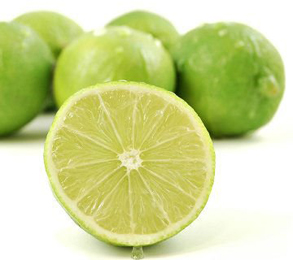Lime, Lemon (Citrus limon)
Description of Plant

Citrus limon (Nimbuka) plant is a straggling bush or small tree which is 3-4 meters tall in height, having numerous angular branches and sharp spines in the leaf-axils. The leaves of this plant are acute, alternate, shiny, and evergreen. The flowers are small, white solitary, and hardly 2 or 3 together, in axils. The plant bears yellow ovoid, rounded berry, fruit with a nipple-shaped edges. The plant flowers and fruits almost the whole year.
Its Ayurvedic Name is Jambir kul.
General Information
Citrus limon (Nimbuka) improves all the three doshas, primarily vata and Kapha. It retains light and dry qualities. It is found to be a useful medicine in various diseases and can be used both internally as well as externally.
It can be used for both skin diseases as well as stimulant for digestive system. Its fruits are good source of Vitamin C. It also consists of other Vitamins like Vitamin A, Thiamine, riboflavin, Niacin and also have bio-flavonoids.
The fruits juice comprises 7-10% citric acid, phosphoric acid, mallic acid and citrate, slimy substance and salt. The skin of fruit contains a volatile oil hesperidin, 5-10% and a bitter glucoside.
Classification of Citrus limon
- Kingdom – Plantae
- Division – Magnolophyta
- Class – Magnoliopsida
- Order – Spanidales
- Family – Rutaceae
- Genus – Citrus
- Species – Limon
Habitat
This plant cultivated largely in Andra Pradesh, Maharashtra, Tamilnadu, Gujarat, Rajasthan, Bihar and Goa. Lemons grown in Goa have limited extent in homestead gardens. Limes are accessible throughout the year in some part or the other in our country.
Lime and lemon may be planted in medium black, loamy or alluvial soils with perfect drainage and lacking calcium carbonate layer.
Best suited Areas for growing limes is with dry climate and low rainfall.
Names of Citrus limon in different Languages
- Latin name – Citrus limon
- Common name – Lemon
- Sanskrit name – Nimbuka, Nimbu
- Hindi name Nimbu, Nilbu, Kagaji, Nibu
- Bengali name – Kagazi lebu, Padinabu
- Gujarati name – Goddiya
- Kannada name – Nimbe hannu
- Malayalam name – Erumichairakam
- Tamil name – Elumichai
- Telugu name – Nimma pandu
- Marathi name – Limbu kagaji limbu
- Arabic – Limu
- Parsi – Limu, Lumu E kagaji
Ayurvedic properties
| Hindi / Sanskrit | English | ||
| Rasa | Amla | Taste | Sour |
| Guna | Teekshna, Laghu | Physical Property | Light, Unctuousness, Sticky |
| Virya | Ushna | Potency | Hot |
| Vipaka | Amla | Metabolic Property (After Digestion) | Sour |
Effects on Doshas
It balances Vata and Kapha doshas.
| Charak Samhita | Sushrut Samhita |
|
Phala Varga, Amla varga |
Phala Varga |
Ancient Verse about Citrus Limon

The Bhavprakash nighantu edition of 1998: verse 137-138, page no-595.
Lemon destroys all kinds of worms. It is sour in taste pacifies tridoshaj pains, anorexia, toxins in the body, low digestive fire, intestinal obstruction and cholera.
References
The Bhavprakash nighantu with elaborated Hindi commentary by Padmashri prof. K.C. Chunekar, edited by Dr. G.S. Pandey: edition of 1998: verse 137-138, page no-595.
Properties of Citrus limon
The nimbuka is anthelmintic, appetizer, astringent, refrigerant, diaphroretic, anti-dehydrating and tonic.
Practical Uses of Citrus limon
- The oil obtained from the fruit skin of this herb is applied in fevers like measles, smallpox and chickenpox, and it provides smoothening effects to the skin, after falling out of the scabs .
- In case of non-oozing skin affections, the fruit juice is applied to get relieve from itching.
- The irritation of skin due to mosquito bite is instantly relieved with the application of fruit juice.
- It recovers the sensation of taste, increases an appetite and dry features.
- It helps in secretion of digestive enzymes improving digestion.
- The topical application of fruit juice is said to be effective in dandruff.
- It is also a good appetiser, digestive, mild laxative and cholagogue, therefore, used in various digestive ailments like anorexia, dyspepsia, vomiting, constipation, hepatic disease etc.
- Nimbuka imparts blood purifying action, hence, beneficial in the heart diseases, skin diseases, gout and raktapitta.
- It is a rich source of Vitamin C which makes it helpful in treating bleeding and spongy gums in scurvy.
- It is useful in vomiting, cough, ailments of the throat and tumours etc.
- It is said to be bring good and positive effects in enlarged spleen.
- It benefits in burning sensation.
Part Used
- Fruit
- Fruits Skin
- Leaves
It can be used in the form of juice and decoction.
DOSE: Fresh juice 15-25 ml to be consumed diluted with water.



